617 Search Results for tell me about it
August 28, 2014
by Carole Zangari -
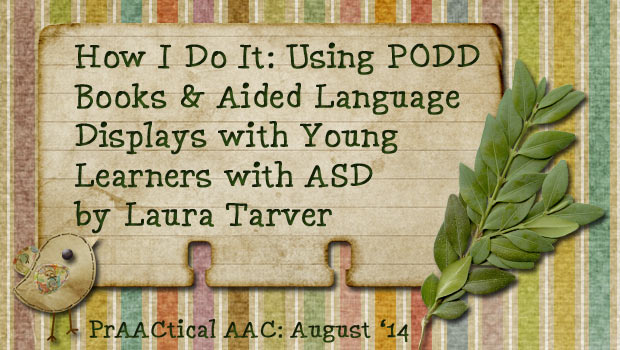
Today, we turn to the UK in a guest post by Laura Tarver. a London-based Speech and Language Therapist working with children with ASD and other complex needs. She previously worked in a primary school for children with ASD, where PODD and Aided Language Displays were introduced as part of a school wide approach in order to enhance the communication-friendly environment for all pupils. In this post, she shares how they used PODD books and aided language input to build the students’ communication skills. :::::::::::::::::::::::::::::::::::::::::::::::::::::::::::::::::: PODD (or Pragmatic Organisation Dynamic Display) communication books were developed in Australia by Gayle Porter, originally for children with cerebral palsy. As their use becomes more widespread throughout the world, practitioners are considering the benefits of using them with other clinical populations. Their structured organisation and emphasis on visual communication means that they are also a valuable tool for developing the communication of those with... [Read More...]
August 26, 2014
by Carole Zangari -
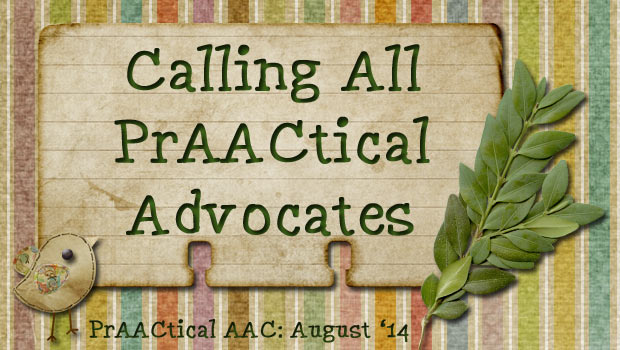
US Colleagues: It’s not too late! We still need your help to tell Congress and Health and Human Services Secretary Sylvia Burwell, to stop denying our most vulnerable disabled people their ability to communicate! The initial advocacy effort was effective in delaying the start date for implementation of the proposed changes but more needs to be done. New to these issues? Check out the post by Bill Binko here. Basically, Medicare has announced several changes to its speech generating device coverage policies that will be devastating to people with complex communication needs. To protect our clients, we believe the Secretary of Health and Human Services, the most senior official responsible for Medicare policy, must be made aware of the harmful effects of these changes and must be asked to reverse them. We must speak up now to ensure our clients also will be able to. You can call Medicare directly to... [Read More...]
July 30, 2014
by Carole Zangari -
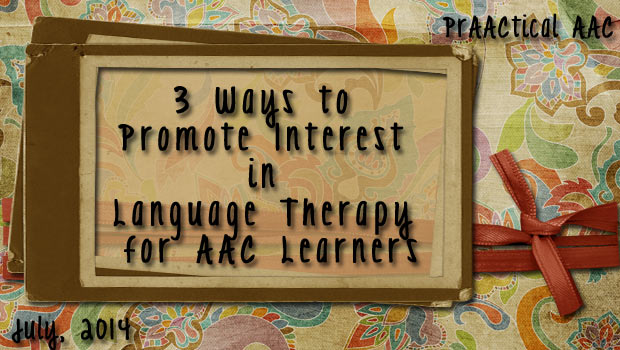
In an earlier post, we raised this question: Why work hard at something you don’t care about? The truth is that all of us put more effort into learning things that allow us to accomplish something important to US. As SLPs, we can spout many reasons why learning to use and comprehend more advanced language is a good idea. Making that meaningful to our clients, though, is another thing altogether. How can we align our therapy objectives with things of true value to our clients? Figure out what the AAC learner wants: More friends? A job? Good grades? Link the language and AAC objectives to those things. Seek the AAC learner’s input on goals and objectives: If the learner can’t nominate his/her own goals for consideration, maybe you can offer choices or help them use a rating scale to give their opinion on the suggested goals. Provide rationales for why... [Read More...]
July 25, 2014
by Carole Zangari -
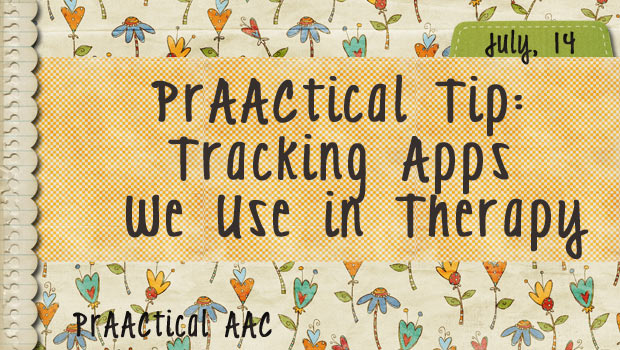
There are so many great apps to use for building communication and literacy skills: games, utilities, e-books, photos, storytelling, etc. There are too many gems to list! Did you ever start to plan a therapy session or some home practice activities using specific apps, only to realize that you don’t know if that client’s mobile device actually HAS the app you plan to use? As you can guess, this has happened to us a time or two. If you are using your own device, this isn’t problematic but often we are trying to build skills with an app that we want to client to use outside of the therapy session. Here’s a quick tip for avoiding that scenario: Take a photo showing the apps the client has on their device and send it to yourself or upload to a cloud (taking care to follow privacy policies if you do the latter).... [Read More...]
June 27, 2014
by Carole Zangari -
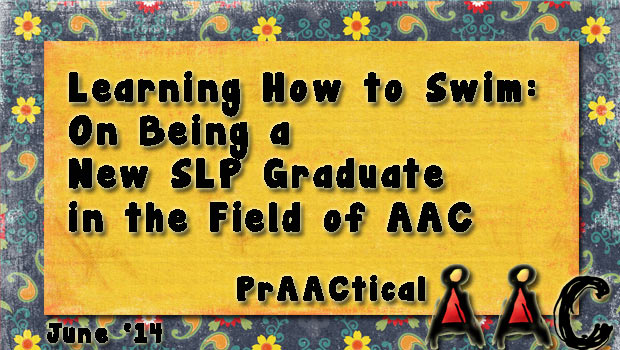
We’re pleased to welcome a new guest blogger, Kate Munro, to our pages today. I first ‘met’ Kate on Twitter (@SpeechieKate) and was even more excited by her passion for AAC when I met her in person last month. Her passion for AAC began during a clinical placement while training at the University of Queensland. This snowballed when completing her honours with Dr. Bronwyn Hemsley on health professional’s views on communication in hospital for children with Cerebral Palsy and CCN. Now living in South Australia, she is a speech pathologist working at Two Way Street, a private practice which specialises in AAC. In addition to this, she tutors students at Flinders University’s Disabilitiy and Community Inclusion Unit and volunteers her time as the South Australian Representative for AGOSCI. Since her honours research was published as part of a larger study, she has developed a greater interest in research but isn’t ready... [Read More...]
June 26, 2014
by Carole Zangari -
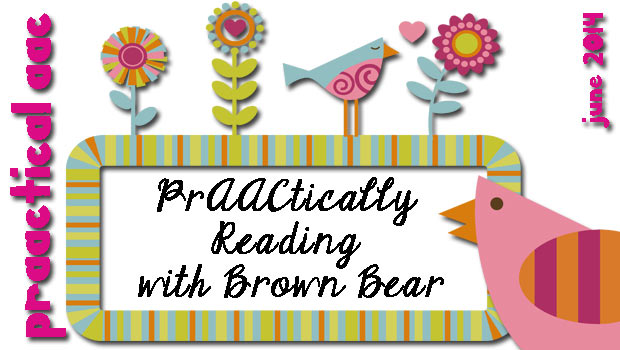
There are so many wonderful things about reading with kids, and practicing AAC is one of them. Every month, we’ll try to pick a book and provide some prAACtical suggestions for how to read it and sneak in some opportunities for receptive and expressive AAC use. You can make book-specific screens, overlays, or boards, but we favor a more powerful approach: use core vocabulary as your base and supplement with words specific to that book. Need some core language displays? There are many floating around, but here’s a link to ours if you need some more. We thought we’d start off this series with a book that is familiar to most, if not all, of you. Pull it off your shelf, find your prAACtical pal, grab that core language board, get to a cozy spot, and let’s get started. PrAACtically Reading with Brown Bear Brown Bear, Brown Bear, What Do... [Read More...]
June 21, 2014
by Carole Zangari -
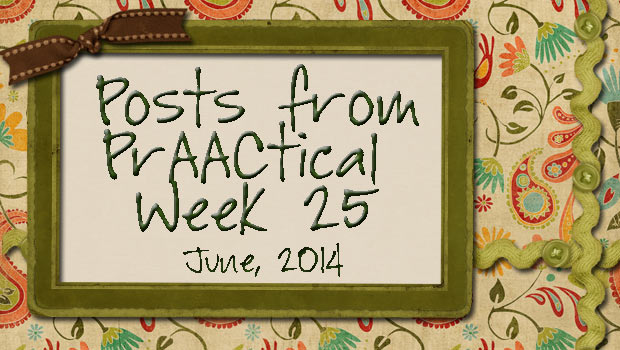
Sunday: Video of the Week – Development of Literacy Skills by Individuals with Angelman Syndrome Monday: Strategy of the Month: Tell Me More: Increasing Sentence Complexity by AAC Learners Tuesday: Teach Me Tuesday – AACORN Wednesday: Watch It Wednesday: A Right to Communicate Thursday: PrAACtically SLPs – Working with Children with Complex Medical Conditions Friday: 5 PrAACtical Suggestions for New SLPs
June 12, 2014
by Carole Zangari -
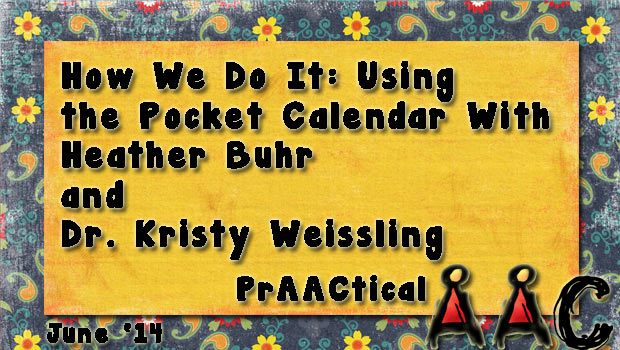
We are happy to welcome back our friend and colleague, Dr. Kristy Weissling, and her student Heather Buhr, who are sharing more information about an AAC tool they are using to support people with aphasia. Take a look at their Pocket Calendars, which may be beneficial to clients with other kinds of communication difficulties as well. You can see their original post, Low-Tech AAC for Adults with Aphasia, here. ::::::::::::::::::::::::::::::::::::::::::::::::::::::::::::::::::::::::::::::::::: In our last post we examined the differences between memory books and communication books. As promised, we are back again to share with you a low-tech “device” that we have been recently using- the pocket calendar. It’s simple, easy to use, comes together in a snap, and is probably familiar to your clients. We will review how our clients are using these pocket calendars, why we find them effective, and how to put one... [Read More...]
June 6, 2014
by Robin Parker -
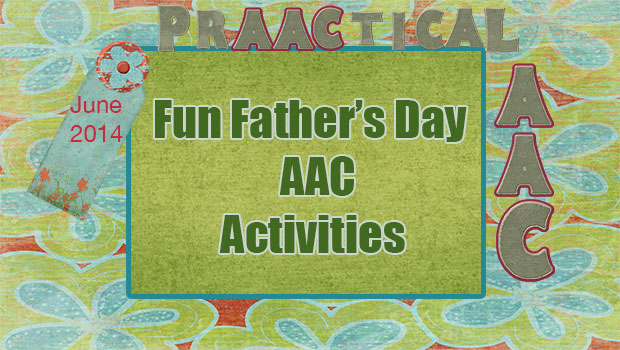
It’s prAACtically Father’s Day. There are many things to talk about, create, eat, and prepare for this special day. Check out these fun activities that can be done during communication therapy, at home, or at school. Some can be done with dad and others can be done for dad as gifts. Enjoy the communication process. Record “I Love You” on a one hit message device/card/picture. You can give a card or talking picture as a gift. You can use the one hit message device to tell dad “I love you” many times for father’s day and beyond. Use Talking to Dad Visual Supports/Worksheets by Joel Shaul at Autism Teaching Strategies to create meaningful conversations Play a memory game with dad that is supported with PCS (Thank you Mayer Johnson) Use a visual recipe to prepare a sweet treat for dad. Consider chocolate covered pretzels. Create a power point book about... [Read More...]
June 5, 2014
by Carole Zangari -
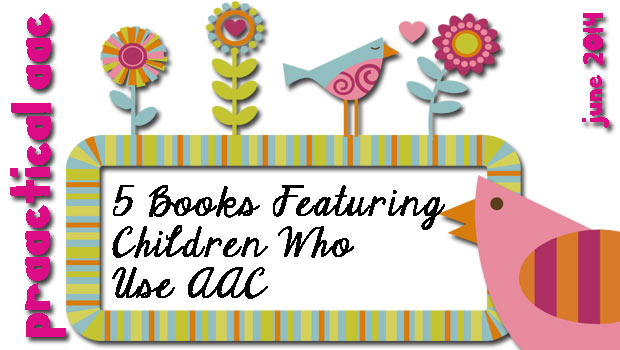
Anyone else thinking of a little summer reading? We were looking for books featuring children who use AAC the other day and thought others might also be interested in this topic. The Boy Who Saw Too Much (Part of the Romeo Riley Private Detective Series) by April Whitt How Katie Got a Voice (And A Cool New Nickname) by Pat Mervine On Being Sarah by Elizabeth Helfman Sara’s Surprise by Nan Holcomb YOURS! Make your own story with digital storytelling apps like My Story – Book Maker What are your favorite books that show children using AAC?









